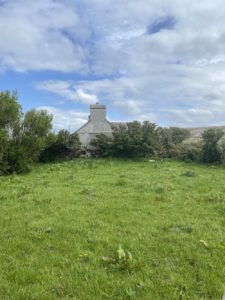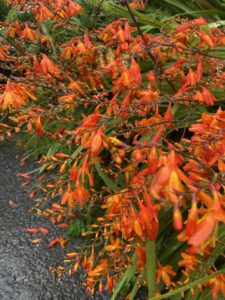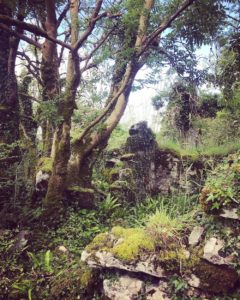Every year, we give over all of December (and usually most of January) to a series called ‘Shadows and Reflections’, in which our contributors share highs, lows and oddments from the past 12 months. Today it’s the turn of Róisín Á. Costello.

In January I have my heart broken. Or I, initially, think the breaking happens in January. It will transpire, in the coming year, that heartbreak does not occupy a definite, temporal space. For the first time in my life, and for month after month of 2022, I find it difficult to sleep. I sit awake as the cool glow of my laptop screen attracts moths to my bedroom window, pressing their small, furred abdomens to the glass as I refresh my screen, for more bad news. Wildfires, and floods and temperature rises that consign the future to uncertainty.
To dwell on something else, or maybe in a search to dwell in a world insulated from this one, I begin searching for houses for sale in the valley beside my parents’ home. Houses in ruins, houses with no electricity, houses cut off from broadband and phone coverage by the winding roads and hunched shoulders of topography. Houses that come with rotting orchards and patchwork gardens, weed-choked wells, and no vehicular access. Houses with one room and barely a roof. Houses without plumbing that you must ford a shallow but wide river to reach. Houses that are made more of memory of their long-ago existence than of material stuff. Fields with spaces where houses used to be, where homes could be built again. I watch hours of video on how to restore houses like this, and then hours more of how to live the life their old owners did. I gobble footage of millennials turned farmers who recommend getting runner ducks to eat the slugs that could otherwise overtake your vegetables. I learn how to house your runner ducks at night so foxes will not eat them. I worry about whether the family sheepdog, unused to ducks, would eat them. I watch as a Canadian woman demonstrates how to build a duck house on YouTube and buy three books on subsistence gardening in a North Atlantic climate. I plumb my relatives for information about how my grandparents, and theirs, planted and harvested their farms here, what they grew, and where, and how they stored it. My uncle walks me across the old family farm, over the rippling ground of the old kitchen garden’s neat rows and past the gnarled remnant of a small orchard, its trees curled in upon themselves by North-Atlantic winds. He shows me the old well where water was drawn and the stone-built outhouse with the pig hook still attached to the ceiling, the empty grate where the blood was cooked into pudding over an open fire.
At night I sit awake as the lights of Connemara flicker on against the dawn and watch maps of wildfires burning out of control on my laptop screen. Angry patches of red flare and sputter across constantly updated maps of places I have called home, fluxing in real time with the destruction in Spain, North America, France. Floods engulf the home of a beloved editor in Australia. I wonder if this is healthy, layering one loss on another night after night. And whether each hurt compounds the other, or just contextualises it.
In June, reports say that populations of swallows and corncrakes and curlews and swifts are all declining. A journalist reports that Ireland has the worst record for biodiversity loss in Europe. I stop reading the news. I do not know that it is heartbreak that makes me do it. I don’t think it is. It is not the process of deliberate separation — of human from nature, life from life — that forces me to close the screen and watch the dawn creeping across the water towards the shore. That cleaving apart is a kind of hurt can be mended, stitched back together with recovered scraps, with time. I think it is worse than that. I begin to think, as a new winter approaches, that I am not heartbroken but hope broken. It is not the pain of loss that keeps me company in the dawns of September. It is the desolation that comes with certainty. That the news never improves — and never will. Of seeing things once thought unlosable being lost. Of knowing that this is how things are now. That what is left is all there is. And what do you do with broken hope. Maybe you find a ruin. You plant a garden; you clear a well.
In September, a cottage on the mountain behind my parents’ house is put up for sale. It is a small, white painted building that has been derelict for the twenty years since its last owners died. I cannot convince the bank to give me a mortgage to buy it. It is barely watertight. Two centuries old. Tiny. On the side of a mountain. It is not damp as much as soggy. It is overpriced. I am single. I work on the other side of the country. The bank does not care that it has a good aspect for a cottage garden, its own spring, two old apple trees, a stone built chimney, that it is where I think of as home. The bank does not know that vivid orange crocosmia line the garden path to the front door every summer, or that the sheepdog that used to live there had a ring of the same orange around his pupils. The bank does not know that the hand-built stone wall that borders the front garden is a work of art, its top stones picked by the builder for their unusual shapes so that a crenelation of twisted limestone figures dance along the roadside. Mermaid, giant’s eye, dragon. In December, a couple from the city buy the cottage for twice the asking price.

The day after I hear it has sold, I climb the mountain across the valley. A storm has blown the dandelion clocks bald. The skies have been cleared too, scrubbed to an echoing, vaulted clarity. Once I get high enough on the mountain’s flank I can see the valley mouth in the distance, a sliver of the sea beyond it. The navy shadow of the distant mountains across the bay is dwarfed by white cumulonimbus clouds that billow over them, like a ship’s sails, straining to pull the landscape towards something just out of frame.
The track that leads up the mountain fades after the second gate I climb over, but I follow the rough edge of where the path once was, picked out in slightly greener grass, until I reach two ash trees. In Irish, a tree branch has the same name as a human limb, géag, and the arms of these two tangle above my head as I pass beneath. Their canopies shield the ruins of the village, obscuring its shape so that it cannot be seen either from the valley below, or the slope above. The village is a secret. Visited only with permission of the family on whose land it sits, its location must be known rather than learned. Beneath the trees, is a cluster of seven or eight buildings. The thatched rooves are long gone, fallen into the rooms below to feed deep beds of nettles and ferns. The walls are all that is left, spattered with the egg yolk yellow of caloplaca lichen, the joints between the stones cushioned with white stonecrop and saxifrage. I wade into one of the cottages, parting the waist high grass and ferns. In the space where the hearth once was there is a large slab of rock. I sink down to sit on it and am submerged in the whistle of wind moving through branches, and frost burned grass. The space in front of me was once the kitchen. My back would have been warm, sitting here in front of the fire. But it is cold today.

In one of her poems, the Irish poet Doireann Ní Ghríofa lists the false friends that populate the Irish language — words whose pronunciations echo misleadingly off English words they bear no relation to. ‘The Irish for secret is ruin’ she writes. And it is. The Irish for secret is rún. It seems like a fitting pairing here, in the remains of a hidden village, in a valley I have pinned my hopes to over the last year. Because rún is not just a secret. It is also a resolution, a purpose or objective, a thing or person that is beloved.
The village was abandoned gradually, or maybe all at once. It depends on which story you believe. Either one leads here. To stone walls slowly withering back into the landscape. And a handful of people who survived in the valley below to keep its secrets. Some year — sooner, or later, even the limestone of these walls will go, the calcium carbonate in the stone eaten away by the acid of the rainwater that trickles down through the canopy of ash. The chemical process that causes that erosion is called solution, and it is not a product of climate change, but of nature. The end of things is woven into their beginning. Even if we cannot see it.